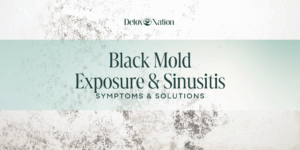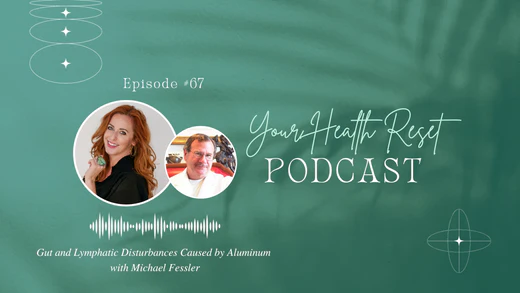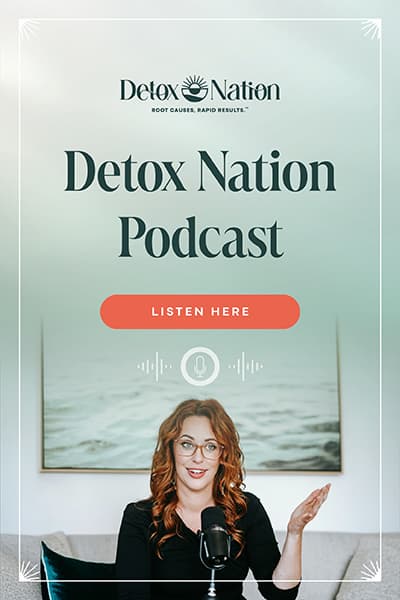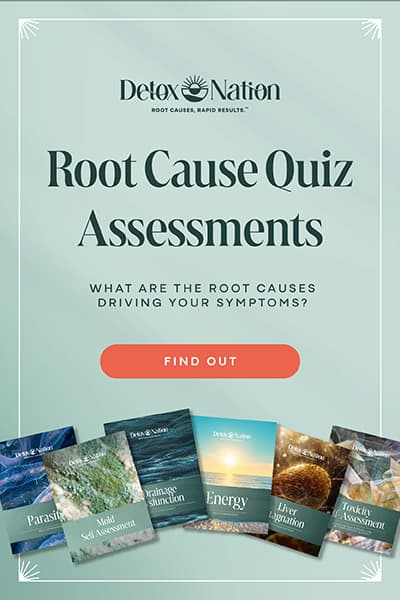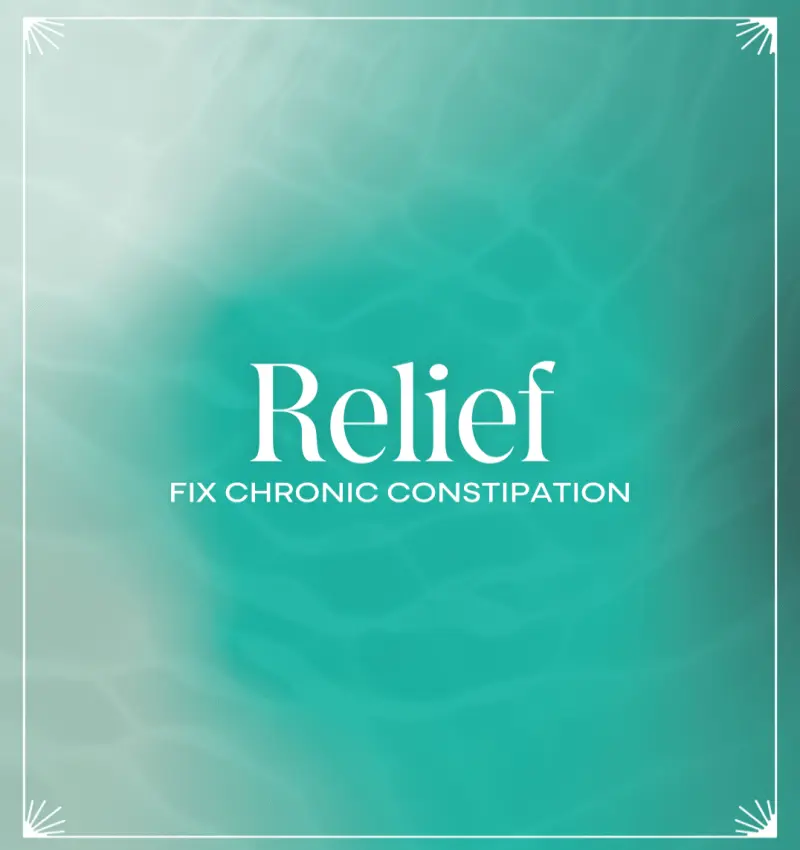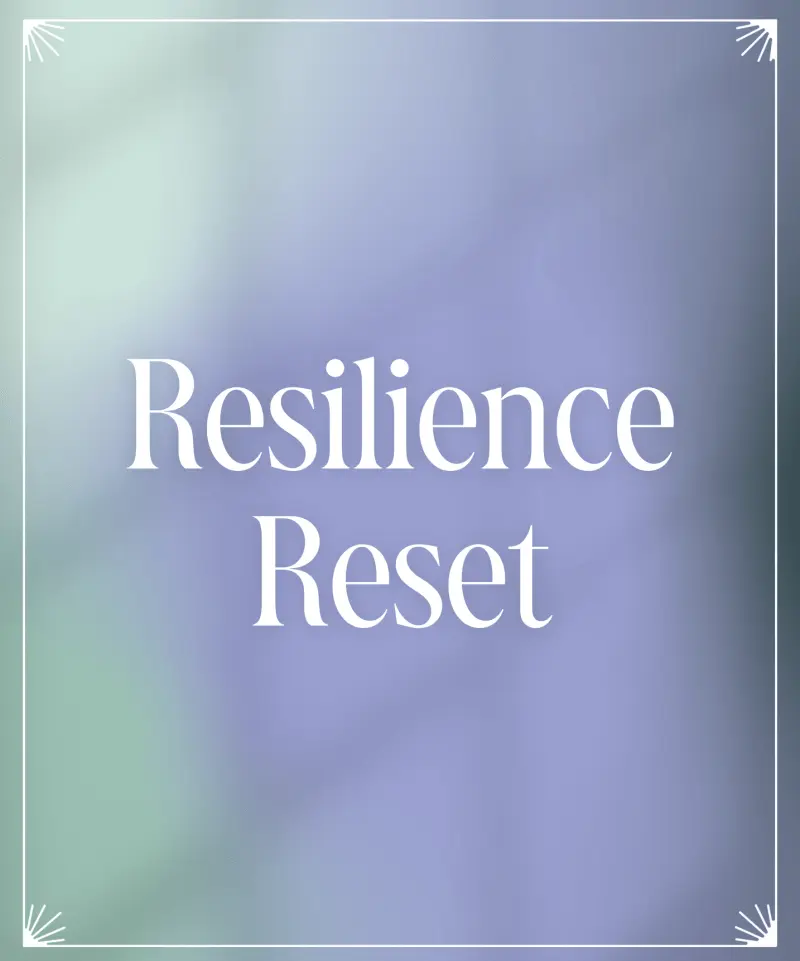You’ve probably said it to yourself more than once: “Why does my body freak out every time I eat something ‘healthy’?”
You’re living in a body that’s reacting to everything—spinach, bone broth, red wine, probiotics, even the air sometimes—and no one seems to have a real answer.
Your symptoms might look like:
- Feeling wired but exhausted after meals
- Random itching, flushing, or hives
- Waking up at 2 a.m. with your heart racing
- Migraines that come out of nowhere
- Bloating and gas after almost anything you eat
- Or maybe just that vague sense of “my body hates me right now”
You’ve tried elimination diets, enzyme supplements, and maybe even rounds of antibiotics.
You’ve probably heard words like histamine intolerance, leaky gut, or mast cell activation floating around online—each one sounding promising but somehow still vague.
Let’s cut through the noise.
Key Takeaways
- Leaky gut is the gateway to mast cell and immune chaos.
- Histamine itself isn’t the enemy—overload is.
- You don’t need more restriction—you need to restore your body’s capacity to handle life again.
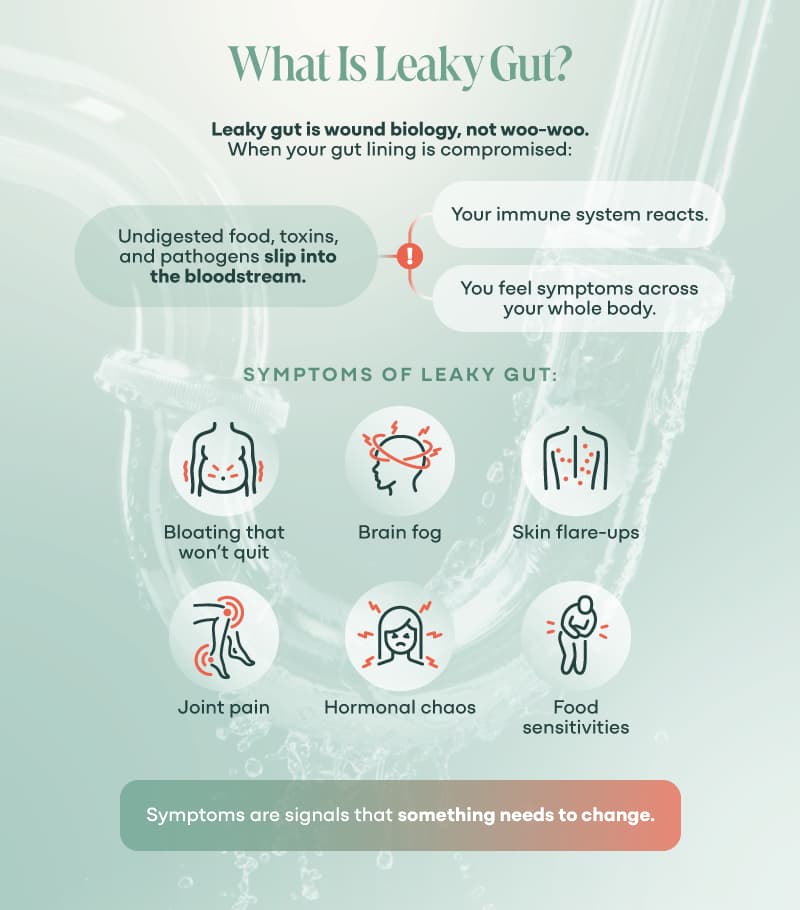
What Is Leaky Gut? aka Intestinal Permeability
You’ve probably heard the term “leaky gut” tossed around like it’s a trendy wellness buzzword.
But let’s be clear—it’s not woo.
It’s wound biology.
And it’s real.
Your gut lining is supposed to be like cheesecloth—porous enough to let nutrients through, but tight enough to keep invaders out.
When it’s working well, it’s your body’s most elegant security system.
But when it gets damaged?
It’s like the zipper breaks and everything—undigested food, bacterial toxins, environmental chemicals—starts slipping into places it shouldn’t be.
This is what we mean by increased intestinal permeability.
It’s the gateway dysfunction that quietly fuels dozens of chronic symptoms.

What Breaks the Barrier?
It’s not just one thing. It’s everything all at once:
- A lifetime of glyphosate-soaked foods
- Chronic stress (yep, that cortisol spikes gut permeability)
- Mold or mycotoxin exposure
- Parasites, pathogens, and latent viruses
- Antibiotics that wiped out the good flora
- NSAIDs like ibuprofen
- Gluten—even if you’re not “gluten sensitive”
Over time, this onslaught inflames the mucosal barrier and weakens the tight junctions between your gut cells (aka enterocytes).
That means your bloodstream gets exposed to stuff it was never meant to see—setting off alarm bells in your immune system and turning every mealtime into a possible war zone.
And here’s the kicker: 80% of your immune system lives right behind that gut lining.
So, when the wall gets leaky, it’s not just your digestion that takes a hit—it’s your whole immune response.

Symptoms of Leaky Gut
- Bloating that won’t quit
- Brain fog and “bad memory days”
- Skin flare-ups (eczema, acne, mystery rashes)
- Joint pain that moves around
- Hormonal chaos
- Food sensitivities that seem to multiply overnight
You don’t need a colonoscopy or fancy diagnosis to know something’s wrong.
You feel it every time you eat and don’t feel better afterward.
But the most important part?
This isn’t just happening to you.
It’s happening for you.
Your body is signaling: “Something in the terrain needs to change.”
Healing from leaky gut starts with you, but you’re not alone.
Take our mold assessment to see if mold toxicity may be at the root of your leaky gut symptoms.
Take the free Mold AssessmentDysbiosis, Inflammation & The Microbial Drama
Let’s talk bugs.
Because not all bacteria are bad—but when the balance tips, the gut turns into a biochemical dumpster fire.
Your microbiome is supposed to be a diverse, collaborative ecosystem.
Think rainforest, not monocrop.
But thanks to the usual suspects (antibiotics, pesticides, processed food, toxic stress), most people are walking around with a gut that’s less like a rainforest and more like an abandoned strip mall after a hurricane—missing storefronts, no security, and squatters everywhere.
What Is Dysbiosis?
Dysbiosis just means microbial imbalance—too many bad guys, not enough good ones, and often, a loss of diversity overall.
The wrong bugs in the wrong numbers start producing the wrong kinds of byproducts. And your body feels it.
A few key problems that show up in dysbiosis:
- Histamine producers take over – Bugs like Klebsiella, Proteus, Morganella, and even some Lactobacillus strains start cranking out histamine as part of their metabolism (8, 21, 22, 30). If your body can’t break it down fast enough, the result is overload—headaches, flushing, rashes, mood swings.
- Butyrate producers drop off – These short-chain fatty acid producers keep the gut lining strong and inflammation low. When they’re gone, the gut wall weakens, and the immune system loses its chill.
- Pathogens and parasites move in – Remember, nature abhors a vacuum. If you lose the good guys, there’s always something lurking in the wings ready to fill the space (looking at you, candida and blastocystis).

Inflammation Makes Everything Worse.
The microbes that overgrow during dysbiosis often trigger low-grade inflammation in the gut lining.
Over time, this disrupts the gut’s electrical signaling and mucosal immune system—that lights up the mast cells living nearby—and triggers them to release histamine (16, 21, 22, 25, 28).
So now you’ve got:
- A thinned-out mucosal barrier
- A flood of bacterial byproducts (aka endotoxins)
- Hyperactive immune cells
- Histamine leaking into the bloodstream
- And no idea why eating a salad mad
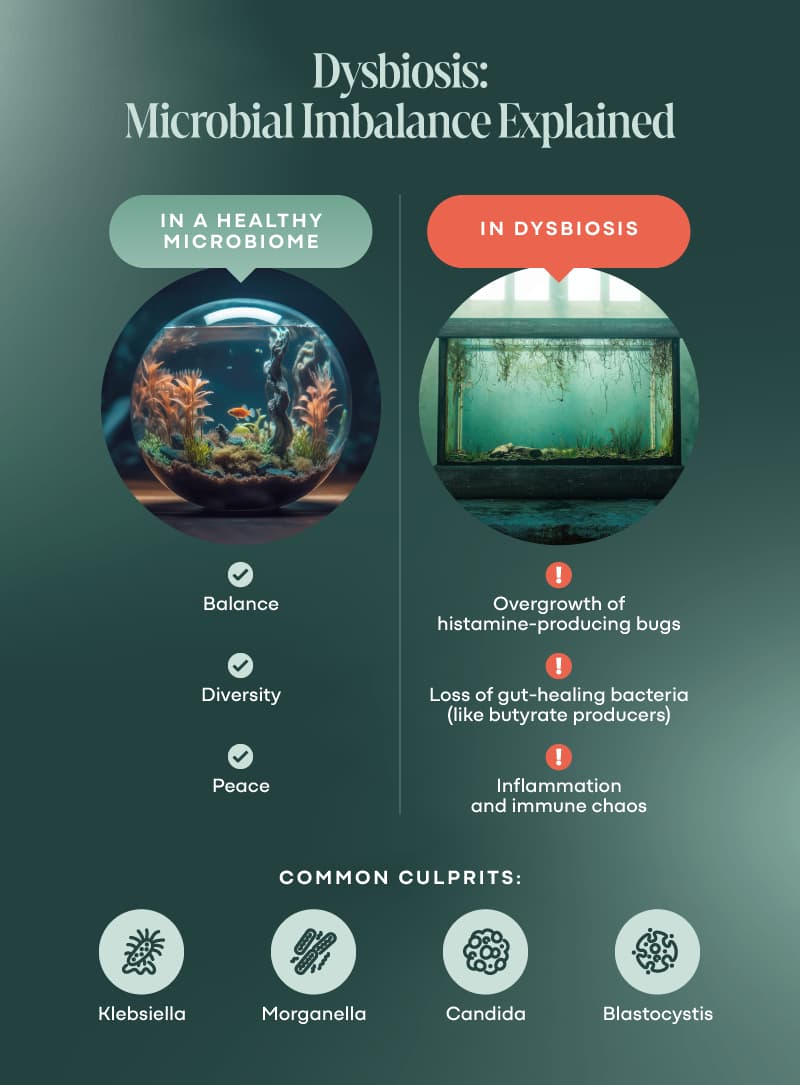
Bonus Drama: Biofilm Fortresses
Some bacteria build a slimy shield around themselves called biofilm—a kind of microscopic invisibility cloak that makes it harder for your immune system to detect them and harder for treatments to reach them (40).
That means these little guys can keep triggering inflammation without ever getting booted out.
It’s a long con—and your gut pays the price.
Dysbiosis is never “just a gut issue.”
It’s a full-body stressor—fueling immune reactivity, hormone imbalance, nutrient depletion, and neurological symptoms all at once.
So, if you’ve been on probiotics that made you feel worse, or you swear your gut hates even the healthiest foods right now, you’re not imagining things.
You might be feeding the wrong bugs.

Histamine Intolerance: When the Bucket Overflows
Let’s start with the truth: histamine isn’t the enemy.
It’s a vital signaling molecule—helps your brain stay alert, regulates stomach acid, supports your immune response, and even gets involved in ovulation (1, 5, 8, 10).
The problem isn’t histamine itself—it’s too much histamine, in the wrong place, at the wrong time.
Think of histamine like a bucket.
Your body adds histamine through foods, microbial byproducts, stress, infections, and toxins.
Normally, you’ve got a clean-up crew—mainly an enzyme called diamine oxidase (DAO)—that keeps the bucket from spilling over.
But if DAO isn’t doing its job? The bucket floods.
Why DAO breaks down:
- Leaky gut: DAO is made in the gut lining. If that lining is damaged, production drops and histamine increases (5, 21, 24).
- Nutrient deficiencies: DAO needs vitamin C, copper, and B6 to work (10, 11).
- Genetics: Some people have slower DAO or impaired histamine breakdown (e.g., MTHFR, HNMT SNPs).
- Dysbiosis: Some gut bugs dump more histamine into the system, and some even inhibit DAO (21, 25, 28).
- Alcohol & medications: NSAIDs, antibiotics, and even some antidepressants block DAO activity (24, 28).
The result? Histamine builds up and starts causing all kinds of symptoms—most of which seem totally unrelated to each other… until you know what to look for.
Histamine intolerance occurs when your ability to clear histamine is less than the amount you’re ingesting or is being made in your body (5, 10, 11, 17, 21, 22, 23, 28).
Common Signs of Histamine Intolerance:
Skin Symptoms
- Flushing – like a hot flash with no heat (9, 10, 11, 14, 16, 18, 26, 28)
- Itching that makes you want to crawl out of your skin (4, 9, 10, 11, 14, 16, 17, 21, 22, 24, 26, 28)
- Hives (4, 9, 10, 11, 14, 18, 21, 22)
- Eczema (4, 21, 22, 24, 28)
- Rashes like that mystery redness that comes and goes (10, 17, 18)
Digestive Symptoms
- Abdominal Pain where your gut feels like it’s fighting back (4, 5, 10, 11, 14, 16, 21, 22, 23, 24, 28)
- Nausea when you’re queasy for no good reason (3, 4, 10, 14, 16, 17, 21, 24)
- Bloating that has your belly ballooned by 4 p.m. (4, 5, 11, 21, 22, 23, 24, 28)
- Diarrhea with sprint-to-the-bathroom urgency (4, 5, 9, 10, 11, 14, 16, 18, 21, 22, 23, 24, 28)
- Constipation (4, 5, 10, 11, 21, 22, 24, 28)
- Gas with embarrassing stink that won’t quit (4, 11, 21, 22, 24, 28)
- Reflux that burning throat even after “safe” foods (18, 21)
- Feeling of fullness after eating (4, 5, 22, 23, 24)
- Feeling worse with fermented foods, leftovers, or probiotics
Cardiovascular Symptoms
- Heart palpitations that thudding in your chest, out of nowhere (5, 23, 24)
- Hypotension that gives you a dizzy drop when you stand up (4, 9, 10, 14, 22, 26, 28)
- Tachycardia – a racing heart with zero warning (10, 11, 14, 17, 22, 28)
- Dizziness where the room tilts for no reason (4, 5, 14, 21, 23, 24, 28)
Respiratory Symptoms
- Runny nose or congestion after eating (4, 9, 11, 22, 24, 28)
- Asthma or wheezing (9, 14, 21, 24)
- Shortness of breath where you can’t catch your breath, again (10, 11, 14, 18, 21)
Neurological Symptoms
- Headaches or migraines (especially after wine or chocolate) (3, 4, 5, 9, 11, 17, 18, 21, 22, 23, 24, 26, 28)
- Brain fog where it feels like you’re thinking through molasses (3, 18, 26)
Other Systems / Constitutional Symptoms
- Irregular menstrual cycles – hello, surprise periods and cycle chaos (11, 18, 24, 28)
- Insomnia and fatigue – you’re wired, tired, and wide awake (18, 21)
- Muscle, bone, or joint pain – body aches that move around (18, 21)
Does this sound like you?
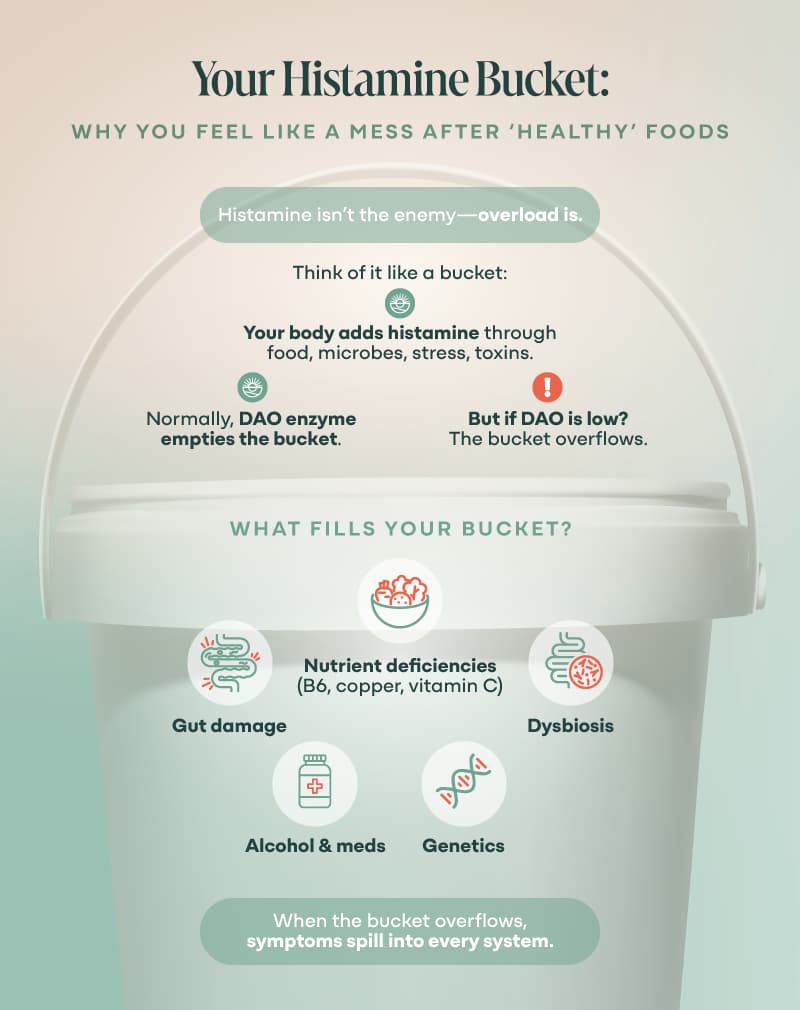
Here’s the hard part: because symptoms are scattered across systems, histamine intolerance gets misdiagnosed constantly (7, 9 28)—as anxiety, IBS, rosacea, chronic fatigue, or even “just getting older.”
And most practitioners? Aren’t trained to look for it.
Your histamine bucket didn’t overflow overnight.
It was a slow drip of stressors—stacked on a leaky gut, nutrient depletion, and microbial chaos.
While a low-histamine diet might bring short-term relief (and sometimes it’s necessary for that breather), it’s not the root fix.
The goal isn’t to fear histamine forever—it’s to restore your capacity to break it down.
That means:
- Healing the gut lining
- Cleaning up the microbial terrain
- Supporting drainage and detox
- Calming the nervous system
- And getting DAO back online
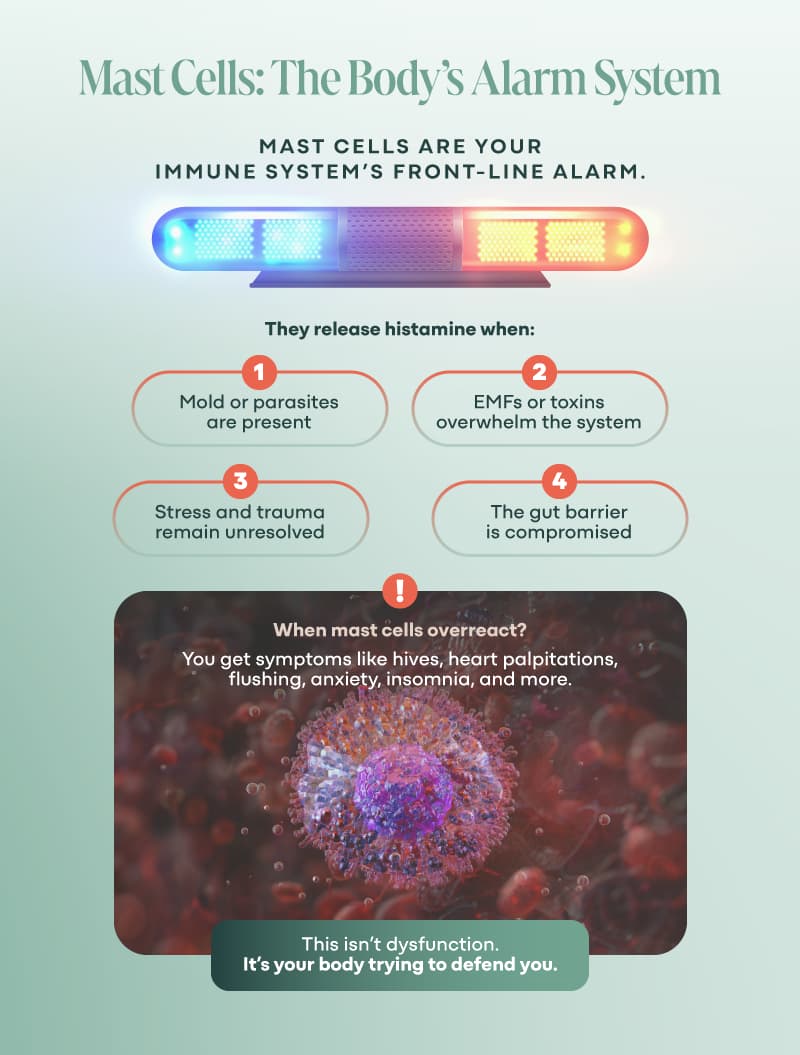
Mast Cells & the Overloaded Alarm System
If histamine is the flood, mast cells are the fire hydrants.
These immune cells live in your connective tissue, especially along the gut lining, nerves, skin, and blood vessels—basically, all the places where your body meets the outside world.
Your gastrointestinal tract has the largest population of mast cells (29), and they use histamine to communicate with your central nervous system (30).
Think of them as your body’s frontline alarm system (2, 29).
When they sense danger, they sound the alarm by releasing chemical messengers—including histamine.
It’s a brilliant design.
Until it isn’t.
What Triggers Mast Cells to Degranulate (aka Explode)?
- Mold or mycotoxins (3, 6, 26)
- Parasites, bacteria, viruses (2, 5, 10, 23, 26, 28, 29)
- Pesticides and plastics (41)
- EMFs (yep, your Wi-Fi might be stressing your cells) (38, 39)
- Food additives and high-histamine foods (1, 11, 21,23, 28)
- Chronic stress (37)
- Trauma (emotional trauma is physical) (37)
And when you’ve got a leaky gut?
Mast cells near the gut lining are getting bombarded constantly—because that barrier’s job is to keep potential threats out, but now they’re leaking in.
So, the mast cells panic.
They stop behaving like quiet security guards and start acting like toddlers with flamethrowers.

What Is Mast Cell Activation Syndrome (MCAS)?
MCAS happens when your mast cells are chronically overactive—releasing histamine and other mediators at the drop of a hat.
Sometimes even without a clear trigger.
(The official diagnostic criteria are complex and can be hard to satisfy due to the requirement of a positive blood test within 4 hours of a symptom.) (9, 13, 14, 25, 27)
It’s like your immune system is stuck in fight-or-flight, seeing threats where there are none.
Symptoms (like we reviewed earlier) can be sneaky and change daily, making it hard to diagnose.
Instead of looking for the official diagnosis, let’s look at it in terms of metabolic chaos and dysregulation.
Mast cell activation isn’t just about histamine.
It’s about nervous system dysregulation, trauma, toxic burden, and microbiome chaos—all combining to create a hair-trigger immune response.
Mast cells aren’t misbehaving—they’re responding to a terrain that feels unsafe.
And if you’ve ever felt like your symptoms are random or you’re “overreacting,” let me reframe that: Your body is having a logical response to the stressors it’s been under.
You’re not fragile—you’re adaptable.
And that means you can adapt your way back to safety and flow, too.

Diagnoses That Get Confused With This Mess
When your symptoms are all over the map, so are the diagnoses.
If you’ve ever walked out of a doctor’s office with a label that felt like a shrug in disguise—“It’s probably IBS,” “Could be anxiety,” “Maybe fibromyalgia”—you’re not alone.
The truth is that leaky gut, histamine intolerance, and mast cell activation can mimic a wide range of conditions.
They don’t show up neatly.
They don’t follow textbook patterns.
And they don’t play nice with standard lab tests.
Here’s what these terrain-driven issues often get mistaken for:
Common Misdiagnoses or Overlaps:
- IBS/SIBO: Bloating, gas, bowel changes, nausea? Could be gut bugs… or could be mast cells in the gut lining reacting to food and stress (28). People with IBS are four times more likely to have MCAS than those without IBS (32).
- POTS (Postural Orthostatic Tachycardia Syndrome) or Dysautonomia: Dizziness, fast heart rate, and fatigue? Sometimes driven by mast cell mediators causing vascular instability (7)
- Anxiety or Panic Disorder: Heart racing, chest tightness, sense of doom? Histamine and norepinephrine released from mast cells can spike these reactions.
- Fibromyalgia or Chronic Fatigue Syndrome: Muscle pain, fatigue, unrefreshing sleep? These can be downstream effects of inflammation, mitochondrial dysfunction, and dysbiosis.
- Rosacea or Chronic Urticaria: Skin reactions might not be “just sensitive skin”—they may point to histamine overload or MCAS.
- Autoimmunity: Chronic immune activation from leaky gut and microbial translocation can mimic early autoimmune symptoms—without yet crossing the diagnostic threshold.
- Other Misdiagnoses Include: Food allergy or intolerance (28), celiac disease (28), Hereditary Alpha Tryptasemia (9), eosinophilic gastroenteritis (28), and systemic mastocytosis (28).
This is why so many people spend years in diagnostic limbo.
Because what you’re experiencing isn’t a single disease—it’s a dysregulated terrain.
And conventional medicine doesn’t have a tidy billing code for that.
You don’t need a new diagnosis.
You need a new framework.
Once you understand how your gut, immune system, and nervous system interact, your symptoms stop looking like a mystery… and start looking like a map.
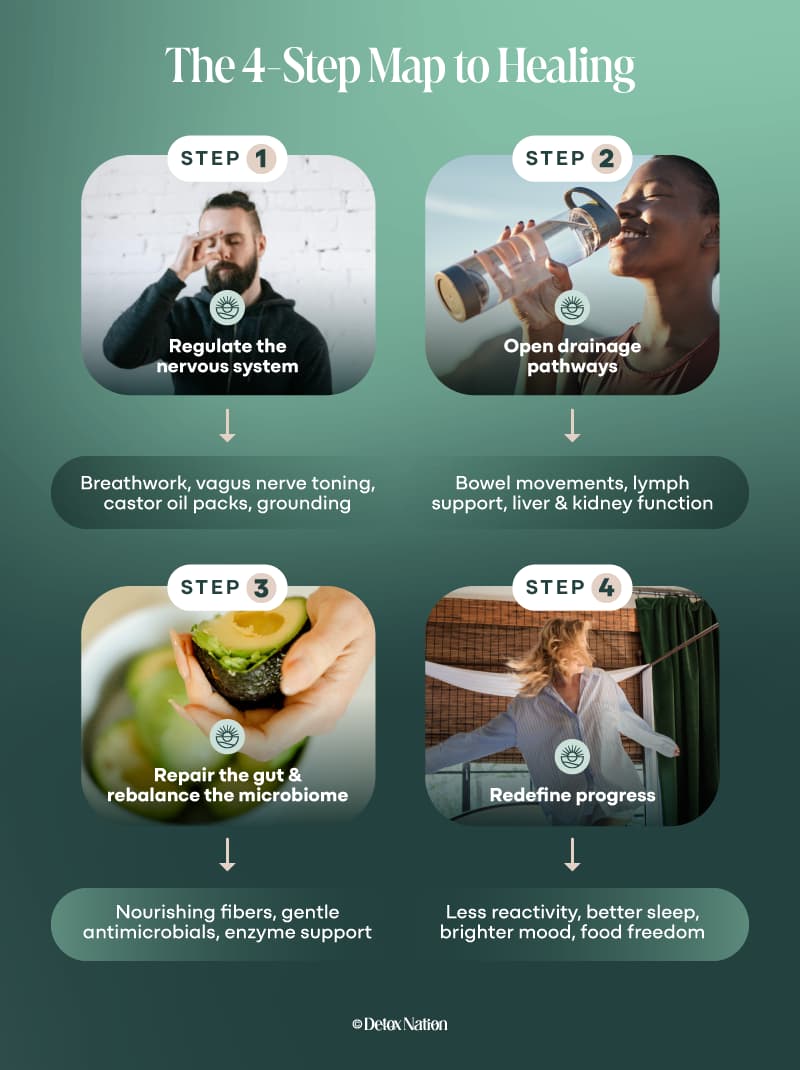
What You Can Do Right Now (That Isn’t Just Another Pill)
At this point, you might be thinking: “Okay, I get it—my gut is wrecked, my immune system is in panic mode, and my histamine bucket is overflowing. But what the hell am I supposed to do about it?”
Let’s start with what not to do:
Don’t just throw more supplements at it.
Don’t obsess over a perfect low-histamine diet.
And please, don’t start a parasite cleanse without checking your drainage first. (I’ve seen that movie. It’s a horror story.)
Instead, here’s a map for dealing with histamine intolerance, leaky gut, or MCAS—especially when you’re sensitive to everything:
Step 1: Regulate Your Nervous System
If your body doesn’t feel safe, nothing else works.
You can’t digest, detox, or sleep when your Vagus nerve is in a chokehold.
This is non-negotiable.
Start here:
- Diaphragmatic breathing
- Lymphatic brushing or bouncing
- Gentle Vagus nerve toning (like humming or gargling)
- Castor oil packs to downshift inflammation
- Walking barefoot outside if possible (yes, really—grounding works)
Your nervous system is the CEO of your gut and immune system. Give it a reason to take its finger off the panic button.
Step 2: Open Your Drainage Pathways
If you try to “detox” without open exits, guess what?
Everything backs up.
And those “detox symptoms” you feel? That’s re-tox.
Focus on:
- Daily bowel movements (if you’re not pooping, nothing’s leaving)
- Liver and bile support
- Gentle lymphatic movement (rebounding, dry brushing)
- Kidney and skin detox support (hydration + sweating = magic)
This isn’t glamorous, but it’s how you build capacity to heal.
Step 3: Repair the Gut Lining and Reset Your Microbiome
This is where the magic happens—after safety and drainage are in place.
That’s why our Gut Repair Program starts with terrain support before we even touch the gut bugs.
You’ll need:
- Specific fibers and nutrients to nourish the gut lining (think amino acids, polyphenols, and biocell salts)
- Tools to modulate—not bomb—the microbiome
- Enzyme and DAO support if needed, but always as a bridge, not a crutch
No one heals by killing alone.
The real game is terrain restoration.
Step 4: Redefine What Progress Looks Like
Healing isn’t linear.
It’s hierarchical.
Your body has a to-do list, and it’s going to prioritize safety before symptom-free days.
What this might look like:
- Reactivity starts decreasing
- Bowel movements normalize
- Mood lifts or stabilizes
- Foods you had to avoid become tolerable again
- Sleep deepens
- You stop bracing for your next crash
You’re not fragile. You’re rebuilding resilience.
This process doesn’t require perfection.
It requires consistency, curiosity, and compassion for the parts of you that are tired of fighting.
You’re Not Broken—You’re Brilliant
Leaky gut, histamine overload, and mast cell chaos aren’t signs your body is failing you.
They’re signs your body is asking for different conditions—less noise, less burden, more flow.
And that means healing is still on the table.
You don’t need to figure out every piece before you start.
You just need to know the next right step.
Start with safety. Support your drainage. Repair your gut terrain.
Stop fighting your body and start partnering with it.
Because the more you listen to its signals—not silence them—the more capacity you create for real, sustained healing.
If you’ve been dismissed, gaslit, or overwhelmed by information that doesn’t apply to your lived experience, let this be your permission slip: You’re not meant to micromanage symptoms forever.
You’re meant to rebuild trust with your body—one choice at a time.
And I can show you how.
Ready to start healing?
Guiding people to reclaim their health and vitality is our greatest joy. Our entire practice is dedicated to supporting you to be who you really are, at home in your body, because your body is able to heal itself.
Take the Free Mold AssessmentFAQs
Why do “healthy” foods suddenly make me feel awful?
Because your gut is inflamed, your histamine bucket is full, and your enzymes are on strike. This isn’t about the kale—it’s about what your body can’t process right now.
What is histamine intolerance?
It’s not an allergy—it’s an overload. When your body can’t break down histamine fast enough (thanks to mold, stress, gut damage, or bad bugs), it spills into your system and triggers chaos.
Why does my gut feel worse when I take probiotics?
Because many probiotic strains (even the “good” ones) produce histamine. If your terrain is off and DAO is low, those capsules are just adding to the storm.
Is “leaky gut” real or just a trend?
It’s real. It’s called increased intestinal permeability, and it’s what happens when the lining of your gut gets damaged—letting in toxins, pathogens, and food particles that spark full-body inflammation.
What is DAO and why does it matter?
DAO (diamine oxidase) is your main enzyme for breaking down histamine in the gut. If your gut lining is inflamed or you’re nutrient-depleted, DAO production tanks—and histamine builds up.
How do I know if I have dysbiosis?
If your gut feels like it hates you—bloating, brain fog, skin flare-ups, mood swings—it’s probably dysbiosis. Bad bugs are overgrowing, good bugs are missing, and the gut lining is inflamed. Terrain matters more than labels.
Can I recover from this or am I just “sensitive” now?
Yes, you can recover. Sensitivity is a symptom—not a personality trait. When you rebuild your terrain and restore your body’s capacity, your tolerance comes back. This is not who you are. It’s just where you are.



